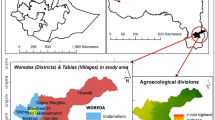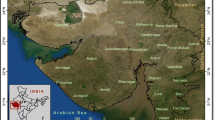Abstract
Drought, an environmental stress is a major crisis of India. Tikamgarh, a district of Madhya Pradesh, is facing the crisis of drought since the last two decades. Rainfall data of the previous years between 1964–1965 and 2011–2012 (crop year) is obtained from Commissioner Land Record (CLR) and crop yield from resource atlas of Tikamgarh. Drought index shows that 52% of the years have mild to severe drought (rainfall deficit) and 48% have no drought but after 1990–1991; 13 years out of 21 have mild to moderate drought and 1 year has severe drought. The last two decades during 1991–1992 to 2011–2012 suffer from drought. Crop yield (cereals, pulses, and oilseeds) is showing continuously increasing trend since 1964–1965 to 1996–1997 and after continuously decreasing. The maximum yield of cereals and pulses for year 1999–2000 and 1996–1997 is 1924 and 883 kg/ha respectively and oilseeds for 1996–1997 is 1122 kg/ha. NDVI modeling shows that natural vegetation is also showing the impact of rainfall variation as severe (2007), mild (2001), and no drought (2012). Crop yield and natural vegetation show the drought impact during 1964–1965 to 2011–2012. Regression model is showing that district witnessed good to very good rainfall (no drought) for two decades and in two decades rainfall-deficit (mild to severe drought) alternately. Rainfall and agricultural correlation are showing that total agriculture depends on rainfall so rainwater harvesting must be implemented for crop saving in Rabi season.






Similar content being viewed by others
References
Asati SA (2012) Analysis of rainfall data for drought investigation at Brahmapuri (ms). Int J LifeSc Bt & Pharm Res 1(4):81–86
Bajaj J K (2012) Resource atlas of Tikamgarh (A celebration of the land and people of Tikamgarh)
Dabral PP (1996) Meteorology drought analysis on rainfall data. Ind J Soil Cons 24(1):37–40
Dash BK, Rafiuddin M, Khanam F, Islam MN (2012) Characteristics of meteorological drought in Bangladesh. Nat Hazards 64(2):1461–1474
Epstein HE, Gill RA, Paruelo JM, Lauenroth WK, Jia GJ, Burke IC (2002) The relative abundance of three plant functional types in temperate grasslands and shrublands of North and South America: effects of projected climate change. J Biogeogr 29:875–888
Erol Keskin M, Terzi O, Taylan ED, Küçükyaman D (2011) Meteorological drought analysis using artificial neural networks. Sci Res Essays 6(21):4469–4477
Groisman P, Knight R, Karl T (2001) Heavy precipitation and high stream flow in the contiguous United States: trends in the twentieth century. Bull Am Meteorol Soc 82:219–246
Indian Meteorological Department (IMD) (1971) Climate diagnostic bulletin of India—June, July, August 1971; Rep. No 88, 89 and 90, National Climate Center, IMD, Pune
Kumar D, Kumar S (1989) Drought analysis based on rainfall data. Ind J Soil Cons 17(1):50–60
Kumar A, Rajpoot PS (2013) Assessment of hydro-environmental loss as surface runoff using CN method of Pahuj River Basin Datia, M.P. India. Proceedings of the International Academy of Ecology and Environmental Sciences 3(4):324–329
Lala IP, Ray PK, Bora V, Ram AK, Singh R, Singh, Feroze SM (2012) Meteorological drought assessment in Barapani, Meghalaya. J Ind Water Res Soc 32(1):56–61
Loveland T, Merchant J, Ohlen D, Brown J (1991) Development of a land cover characteristics database for the conterminous U.S. Photogramm Eng Remote Sens 57:1453–1463
Rajpoot PS, Kumar A (2014) Assessment of environmental stress as meteorological drought due to rainfall variability in Jaipur, Rajasthan (India). International Journal of Scientific Research in Knowledge 2(11):509–516
Rosenberg NJ, Brown RA, Izaurralde RC, Thomson AM (2003) Climate change scenarios and impacts on irrigation water supply simulated with the HUMUS model. Agric For Meteorol 117(1–2):73–96
Roshan G, Negahban S (2015) Modeling of the effects of climate change on rainy and gully erosion potential of Kor-chamriz watershed in Fars province. Model Earth Syst Environ 1:26
Rulinda CM, Dilo A, Bijker W, Steln A (2012) Characterising and quantifying vegetative drought in East Africa using fuzzy modeling and NDVI data. J Arid Environ 78:169–178
Running SW, Loveland TR, Lpierce L, Nemani RR, Hunt ER (1995) A remote sensing based vegetation classification logic for global land cocer analysis. Remote Sens Environ 52:39–48
Sader SA (1993) Personal communication, October The University of Maine, Orono
Shrivastava SK, Rai RK, Pandey A (2008) Assessment of meteorological in north Lakhimpur district of Assam. J of Ind Water Res Soc 28(2):26–31
Small D, Islam S, Vogel RM (2006) Trends in precipitation and stream flow in the eastern US: paradox or perception? Geophys Res Lett 33:L03403. https://doi.org/10.1029/2005GL024995
Tiwari KN, Paul DK, Gontia NK (2007) Characterization of meteorological drought. J Hydrol 30(1–2):15–27
Tripathi SK, Singh M, Pandey A (2007) Agroclimatic variability analysis of Roorkee, Uttarakhand. Journal of Indian Water Resources Society 27(3–4):24–30
Xiao J, Moody A (2004) Photosynthetic activity of US biomes: responses to the spatial variability and seasonality of precipitation and temperature. Glob Chang Biol 10:437–451
Author information
Authors and Affiliations
Corresponding author
Rights and permissions
About this article
Cite this article
Rajpoot, P.S., Kumar, A. Impact assessment of meteorological drought on rainfed agriculture using drought index and NDVI modeling: a case study of Tikamgarh district, M. P., India. Appl Geomat 11, 15–23 (2019). https://doi.org/10.1007/s12518-018-0230-6
Received:
Accepted:
Published:
Issue Date:
DOI: https://doi.org/10.1007/s12518-018-0230-6




